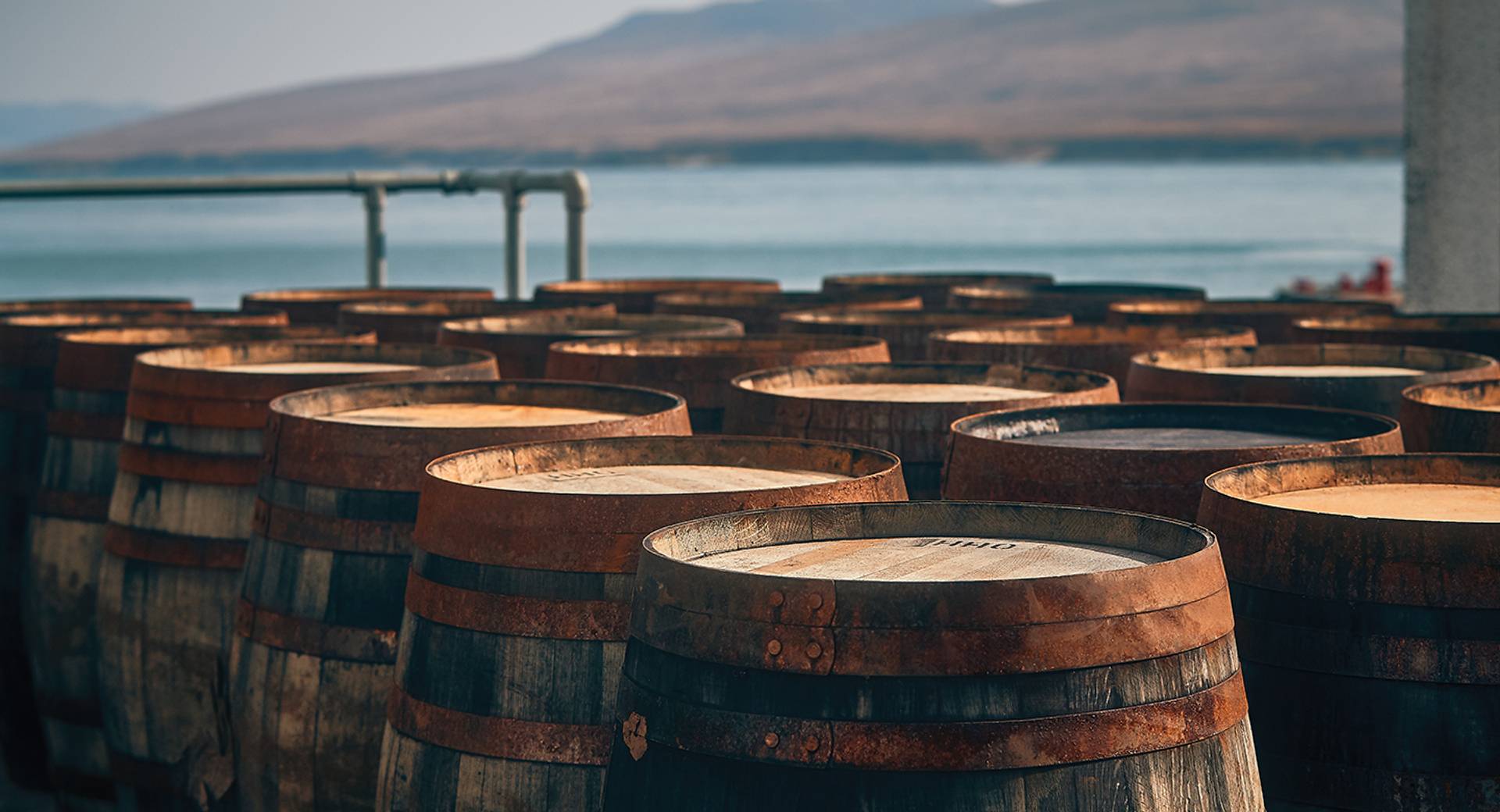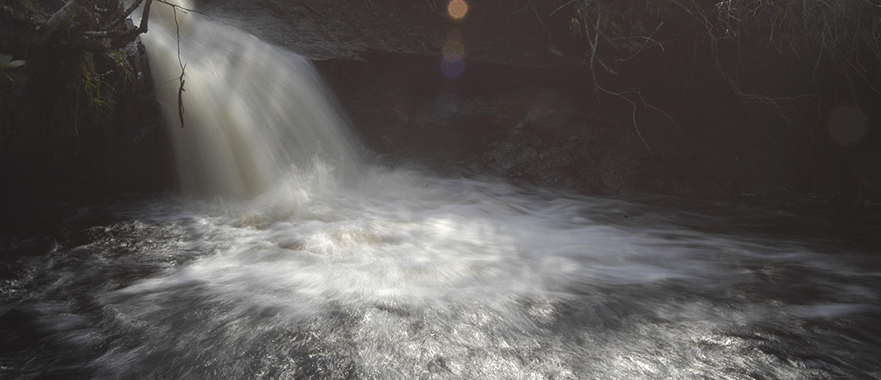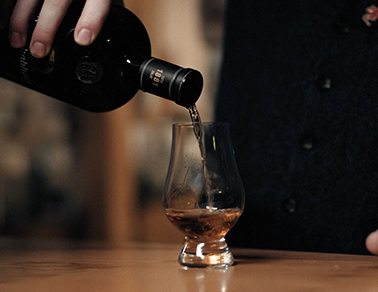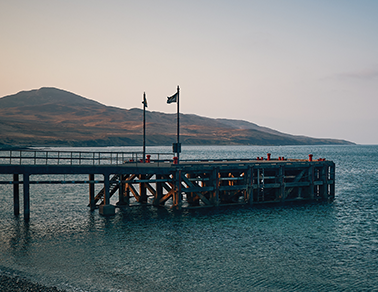
Our Story

First founded in 1881, Bunnahabhain relied upon the sea trade. Armed only with a small village, a pier and lots of whisky making know-how, our forefathers received supplies by boat and sent adventuring seafarers back to the mainland with casks full of whisky.

After a short closure in the 1930s, Bunnahabhain saw one of the biggest changes in its history in 1960, when a new road was built to the distillery. Supplies could now reach us much easier by land – albeit, a hilly and challenging drive.

As word of Bunnahabhain spread and demand soared, a second pair of stills were installed in 1963 to increase the production capacity. In 1979, our classic 12 year old Single Malt Scotch Whisky was introduced to the world, received to great acclaim.

1993 marked a historic moment in Bunnahabhain’s history as the last boat docked as the road was deemed the most suitable route for receiving ever increasing ingredients and supplies. In 2006, 3 years after being purchased by Burn Stewart Distillers, a major rebrand was launched, with a redesign of the 12 year old packaging, and the launch of 18 year old and 25 year old variants.

In 2010, our whiskies returned to being produced non-chillfiltered, with a natural colour at 46.3% abv. In 2014 Burn Stewart merged with Distell, which heralded more investment into both the brand and the distillery. In 2017, our packaging was further modernised, the portfolio of products was extended and in 2021 we opened our brand new Visitor Centre.

Chapter 1
First founded in 1881, Bunnahabhain relied upon the sea trade. Armed only with a small village, a pier and lots of whisky making know-how, our forefathers received supplies by boat and sent adventuring seafarers back to the mainland with casks full of whisky.

Chapter 2
After a short closure in the 1930s, Bunnahabhain saw one of the biggest changes in its history in 1960, when a new road was built to the distillery. Supplies could now reach us much easier by land – albeit, a hilly and challenging drive.

Chapter 3
As word of Bunnahabhain spread and demand soared, a second pair of stills were installed in 1963 to increase the production capacity. In 1979, our classic 12 year old Single Malt Scotch Whisky was introduced to the world, received to great acclaim.

Chapter 4
1993 marked a historic moment in Bunnahabhain’s history as the last boat docked as the road was deemed the most suitable route for receiving ever increasing ingredients and supplies. In 2006, 3 years after being purchased by Burn Stewart Distillers, a major rebrand was launched, with a redesign of the 12 year old packaging, and the launch of 18 year old and 25 year old variants.

Chapter 5
In 2010, our whiskies returned to being produced non-chillfiltered, with a natural colour at 46.3% abv. In 2014 Burn Stewart merged with Distell, which heralded more investment into both the brand and the distillery. In 2017, our packaging was further modernised, the portfolio of products was extended and in 2021 we opened our brand new Visitor Centre.
OUR LOCATION
Discover The Sound of Islay
Our People
Meet the Team

A true Bunnahabhain Veteran, Andrew looks after the day to day production at Bunnahabhain from mash to filling casks. There's not much Andrew doesn't know about our whisky!
Andrew Brown
Distillery Manager
Heading up the blending team, Julieann is responsible for creating our delicious Bunnahabhain whiskies, from core range to limited editions. Always on the lookout for new and interesting casks to mature and finish our whisky in, we can't wait to see (and taste!) what's next.
Julieann Fernandez
Master BlenderOur Process

Bunnahabhain is the only distillery on the island to use pure, spring water. Drawn from the Margadale River via pipes that lead directly to the distillery, our water remains un-influenced by the abundance of peat found throughout the Islay landscape. This pure, unpeated water contributes towards the light signature character of Bunnahabhain.

We use two types of barley, depending on which whisky we are making. For our unpeated whiskies, we use unpeated concerto malted barley and for our Mòine, we use peated concerto malted barley. Both barley types are passed through our Porteus Mill, which grinds it into ‘grist’, before being transferred into our mash tun for mixing with heated spring water.

Our mash tun is one of the biggest in Scotland. It holds 12.5 tonnes and is made of stainless steel with a copper top. The grist from the Porteus Mill and the heated spring water is mixed in a mash cycle that lasts 12 hours, during which time the ‘wort’ (a sweet liquid) is produced.

Our Wort, or sweet liquid, is then drained through the perforated floor of the Mash Tun and transferred to our Wash Backs. We have 6 Oregon pine Wash Backs at Bunnahabhain, each with a capacity of 66,500 litres. It is here that the magic begins, as the yeast is added and the fermentation, which can last as long as 100 hours, is set in motion. As the cooled wort and yeast react to produce a weak alcohol solution called ‘wash’, the natural bacteria within the wood interacts with the yeast and sugars to create additional layers of flavour not achieved by more modern methods and technology.

Once fermentation is complete, we move our ‘Wash’ from the Wash Backs to our Wash Stills where it is heated to the point of evaporation. This evaporation rises to the top of the still, flows down the curved lye pipe to the condenser where it is cooled, and runs on to the low wines receiver. At this stage, the solution is still too weak and impure to be casked, so it is redistilled in a second still called a Spirit Still. With the tallest stills on Islay, which have unusually long swan necks, we are able to produce a lighter, more delicate flavour profile. The second distillation flows through the Spirit Safe, where our stillmen watch for the anticipated middle cut, rejecting the first and final parts of the run. The middle cut, or heart of the run, is stored in the spirit receiver for casking, while the rest is returned to be re-distilled. The ‘heart’ is now our New Make Spirit and has the perfect percentage of alcohol for taking to the next stage of the process. Our stills have a total annual production capacity of 2,500,000 litres.

From the Spirit Receiver, the ‘New Make’ is transferred to the Spirit Vat where water from our natural spring is added. The New Make is then decanted into the highest quality casks and laid to rest in our warehouses which sit alongside the Sound of Islay. Some of our warehousing dates back to 1881 and together have a capacity for 20,700 butts, hogsheads and barrels.

Step 1: Water
Bunnahabhain is the only distillery on the island to use pure, spring water. Drawn from the Margadale River via pipes that lead directly to the distillery, our water remains un-influenced by the abundance of peat found throughout the Islay landscape. This pure, unpeated water contributes towards the light signature character of Bunnahabhain.

Step 2: Barley
We use two types of barley, depending on which whisky we are making. For our unpeated whiskies, we use unpeated concerto malted barley and for our Mòine, we use peated concerto malted barley. Both barley types are passed through our Porteus Mill, which grinds it into ‘grist’, before being transferred into our mash tun for mixing with heated spring water.

Step 3: Mash
Our mash tun is one of the biggest in Scotland. It holds 12.5 tonnes and is made of stainless steel with a copper top. The grist from the Porteus Mill and the heated spring water is mixed in a mash cycle that lasts 12 hours, during which time the ‘wort’ (a sweet liquid) is produced.

Step 4: Fermentation
Our Wort, or sweet liquid, is then drained through the perforated floor of the Mash Tun and transferred to our Wash Backs. We have 6 Oregon pine Wash Backs at Bunnahabhain, each with a capacity of 66,500 litres. It is here that the magic begins, as the yeast is added and the fermentation, which can last as long as 100 hours, is set in motion. As the cooled wort and yeast react to produce a weak alcohol solution called ‘wash’, the natural bacteria within the wood interacts with the yeast and sugars to create additional layers of flavour not achieved by more modern methods and technology.

Step 5: Distillation
Once fermentation is complete, we move our ‘Wash’ from the Wash Backs to our Wash Stills where it is heated to the point of evaporation. This evaporation rises to the top of the still, flows down the curved lye pipe to the condenser where it is cooled, and runs on to the low wines receiver. At this stage, the solution is still too weak and impure to be casked, so it is redistilled in a second still called a Spirit Still. With the tallest stills on Islay, which have unusually long swan necks, we are able to produce a lighter, more delicate flavour profile. The second distillation flows through the Spirit Safe, where our stillmen watch for the anticipated middle cut, rejecting the first and final parts of the run. The middle cut, or heart of the run, is stored in the spirit receiver for casking, while the rest is returned to be re-distilled. The ‘heart’ is now our New Make Spirit and has the perfect percentage of alcohol for taking to the next stage of the process. Our stills have a total annual production capacity of 2,500,000 litres.

Step 6: Maturation
From the Spirit Receiver, the ‘New Make’ is transferred to the Spirit Vat where water from our natural spring is added. The New Make is then decanted into the highest quality casks and laid to rest in our warehouses which sit alongside the Sound of Islay. Some of our warehousing dates back to 1881 and together have a capacity for 20,700 butts, hogsheads and barrels.
Our Location
Visit Us
Bunnahabhain Distillery
Port Askaig
PA46 7RP, Isle of Islay
- Monday
- Tuesday
- Wednesday
- Thursday
- Friday
- Saturday
- Sunday
- 10:00 - 17:00
- 10:00 - 17:00
- 10:00 - 17:00
- 10:00 - 17:00
- 10:00 - 17:00
- 10:00 - 17:00
- 12:00 - 17:00
Frequently Asked Questions
Bunnahabhain is pronounced 'Bunn-na-ha-venn', and means 'mouth of the river' in Scots Gaelic.
If you're not a native Gaelic speaker, some of our whiskies may be a little difficult to pronounce. We are proud of our Gaelic heritage and honour it with our whiskies and their names. If you're having trouble pronouncing something, we'd be more than happy to help - drop us a note on info@bunnahabhain.com or on social media @bunnahabhain. In the meantime, here's some tips: • Stiuireadair - meaning 'helmsman' and pronounced 'Stew-rahdur' • Toiteach A Dhà - meaning 'smoky two' and pronounced Toch-ach ah-ghaa • Mòine - meaning 'peat' and pronounced moi-gna • Cruach Mhona - meaning 'peat stack' and pronounced croo-ach vona • Eirigh Na Greine - meaning 'morning sky' and pronounced ae-ree ne gray-nyuh
No! Whilst our signature style of whisky is unpeated (which is unusual for an Islay malt), we do produce some peated whiskies, reflecting our 19th century origins, when Bunnahabhain malts were strongly peated. If you're a fan of a smoky dram, look out for our mòine (pronounced moi-gna and meaning 'peat' in Scots Gaelic) editions.
If you'd just like to take in the beautiful view over the Sound of Islay and visit our Visitor Centre, you don't need to book, however, if you'd like to attend one of our distillery experiences, we ask you to book in advance. You can do this online by going to: https://bunnahabhain.digitickets.co.uk/tickets
We are currently operating our Warehouse 9 Tasting Experience and tastings in the Visitor Centreat the distillery. We are not currently running production tours. For more information, visit our Tours and Tastings page.
As the most remote distillery on Islay, the easiest way to get to us is by car. There are several taxi companies on the island, or if you're driving yourself, we do offer 'driver's drams' for the designated driver to take away with them if you're attending one of our experiences.
If you're running late, please call the Visitor Centre on +44 (0)1496 840 557 and let a member of the team know your name and what experience you're running late for. When you arrive at Bunnahabhain, please come to the Visitor Centre and we will do our best to catch you up with the tour and/or show you to the tasting experience.
We will try our best to accommodate this, however, cannot guarantee it is always possible as it depends on what bookings we have already committed to. Give us a call on +44 (0)1496 840 557 to chat.
For all online order enquiries, including shipping queries, tax information and requests to amend or cancel an order, please contact our fulfilment partners on distell@mailmarkuk.com
Have a question?
Sign up to our newsletter
Get the latest updates, discounts, news and more


